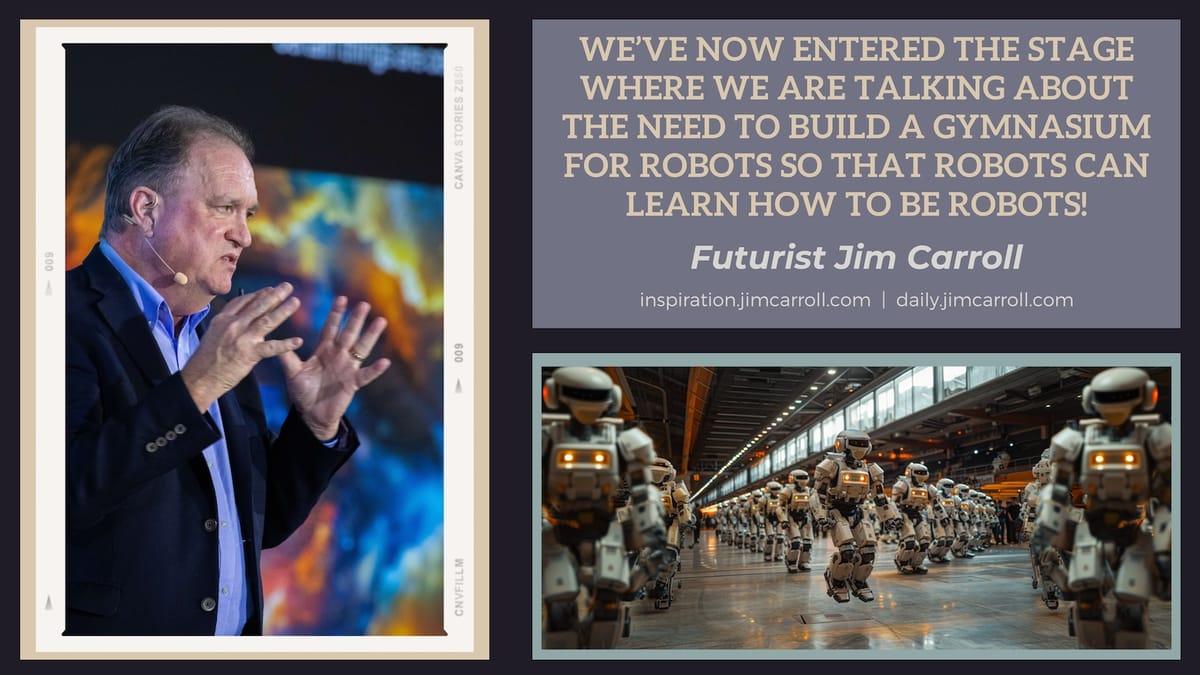"We've now entered the stage where we are talking about the need to build a gymnasium for robots so that robots can learn how to be robots!" - Futurist Jim Carroll
If you follow the world of artificial intelligence at all or are an active investor, you will know that Nvidia has, suddenly it seems, become the world's hottest company.
A manufacturer of chip and computer board technology, its main focus was designing and manufacturing this technology for computer gaming. At the risk of simplifying things, whether by luck or design, everyone discovered that the very same chips could be used to run the incredibly complex software used as the backbone for most artificial intelligence systems. With that, the company has become the most significant player in the A.I. hardware marketplace over the last few years.
Last week, the company held its developer conference - that's where it brings together key customers, computer developers, and others to hear about its plans for the future. It was not unnoticed that the event was held in the same stadium as the NHL's San Jose Sharks, and that the overall attendance exceeded that of a typical game night. The CEO, Jensen Huang, is suddenly the most popular technology pontificator on the planet, and he delivered a keynote that took the assembled personage deep into the world of the future of AI.
These talks are often as much aspirational as they are reality-oriented - often a tech company developer keynote is full of promises as to where the company intends to go as opposed to where they actually are. And yet, they aren't always devoid of facts - they are simply a roadmap to the direction to be followed. And in that context, one section in particular, involving what he announced as Project Groot, caught my attention. In particular, the line that observed that what they planned to do was to allow the building of gymnasiums so that robots could learn how to be robots.
The key section to watch in the video starts at about 01:33:40 on the timeline.
A gym for robots! That phrase certainly captures the attention of a futurist, and it caught mine. With that in mind, let me try and explain what this is all about:
- essentially, the idea brings together three key technologies: augmented or virtual reality, digital twin technology, and robotics
- in the not-so-distant future, humanoid and industrial robots will take on an increasing role in factories, homes, warehouses, medical facilities and more
- they'll need to be programmed and trained on how to undertake the activities that they will actively undertake
- hence, we need to build a place where we can teach them how to do this - in effect, a gymnasium for robots.
While this concept might delight or terrify you depending on your state of mind, I can assure you that this all makes logical sense to me. I wrote about the inevitability of ideas like this in my post on "Non-Immersive AR (Digital Twin) technology" in 2023 and another post in 2019 on 'spatial intelligence.,' among many other posts. I've been speaking and writing about this potential future for years, with comments like this:
We’re moving from a world of two-dimensional ‘location intelligence’ – think of all the things involving GPS technology – to a world of 3D spatial intelligence – and the this will lead the birth of several new “next” billion dollar industries
The opportunities are pretty significant. Location intelligence had us mapping in 2 dimensions; spatial intelligence will have us doing the same with 3dimensions. The trend will involve the data used by self-driving cars to ‘see’ around them; cobots or “cooperative robots” working in 3d dimensions to interact with other robots and humans around them; virtual operations using 3D insight headsets, and so much more!
It's always a thrill to see one of your predicted future trends become real! Let's just say that this is a fascinating, significant, and far-reaching development that will shape our future for many, many years to come. If you want to try to wrap your head around it, I would recommend this video:
What's it all about? Essentially, we'll use something like an Apple Vision Pro to track the movements of a human; we'll use digital twin technology to learn those movements; and we'll feed that data to a humanoid robot so it can learn how to undertake that activity. Hence, a gym for robots so they can learn how to be a robot!
Suffice it to say, I'm going to go into my virtual broadcast studio later today to film a clip that will attempt to put all of this into perspective.
Sometimes, when the future happens around you, it's hard to capture the significance of what you are witnessing.
This is one of those moments.
In his career as a futurist for more than 30 years, Jim Carroll has made many predictions. Many of them have proven to be right.

